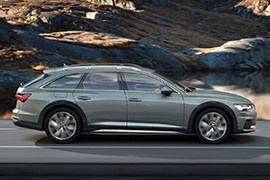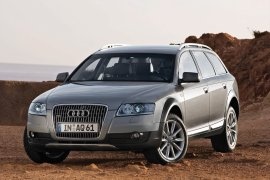
AUDI Allroad
Generations Timeline, Specs and Pictures

Exactly two decades after the nameplate was originally introduced, the fourth generation of the Audi A6 allroad quattro made its debut with the same credentials as its predecessors, including standard all-wheel-drive, adaptive air suspension, increased ground clearance and a more rugged design compared to the standard A6 Avant.
The latest A6 allroad quattro now sits up to 45 millimeters (1.8 inches) higher than the A6 Avant thanks to the variable ground clearance made possible by the air springs. The standard ride height is 139 mm (5.5 in), but if the highest ride height is selected and the speed is max. 35 kph (21.7 mph), the body is automatically raised 45 mm (1.8 in). Apart from the special air suspension and AWD, the model also features standard hill descent control and tilt angle assist, which can help you moderately in slightly more extreme off-road situations. On the European markets, the new A6 allroad quattro is available with a 3.0 TDI V6 diesel in three output ratings. The base model comes with 231 horsepower and 500 Nm (368.8 lb-ft) of torque, the middle spec delivers 286 horsepower and 620 Nm (457.3 lb-ft) of torque, while the top model has 349 horsepower and 700 Nm (516.3 lb-ft) of torque.

The third generation of the A6 Allroad came on the market in 2012 to prove that Audi was right when it decided to introduce a crossover vehicle based on the Audi A6 Avant.
While it wasn’t a real off-road vehicle, it could cope well with unpaved tracks and even tackle some mild off-road trials. Audi protected its bodywork with a few plastic molds all around and stainless-steel plates underneath the car. It sat low on the road than a regular SUV and even lower at higher speeds thanks to its standard pneumatic suspension.
From the outside, the carmaker carried over most of its body panels from the regular A6 Avant, but the bumpers, exaggerated wheel-arches molds and the side sills were unique for it. On top of the vehicle, the carmaker installed roof-rails if someone would need more trunk space. They were more useful to carry bikes and a canoe. Usually, nobody needs more trunk space if it has an A6 Station-wagon.
Inside, Audi installed a comfortable cabin fit for five full-grown adults with plenty of legroom for four and limited for the third, middle passenger from the bench. The dashboard sported a clean design with a pop-out infotainment screen that showed maps from Google Earth. Its user could have expanded the trunk thanks to the split-folding rear seats from 565 liters (20 cu-ft) to a whopping 1680 liters (59.3 cu-ft). It formed a completely flat area, good enough to be used as a bedroom.
Under the hood, Audi offered two gasoline and one diesel engine. The latter was available in four power outputs ranged between 204 hp and 320 hp. All versions sported an all-wheel-drive system with a locking center differential and hill descent control.

After the success recorded by the first generation of the Audi A6 Allroad, the German car-maker decided to build a successor for it and, in 2006, it launched a completely new Audi A6 Allroad.
At the time of its launch, the A6 Allroad quattro was the only vehicle of its kind on the road. It offered the spacious interior of the big A6 Avant, the all-wheel-drive system, and the luxurious interior of the Audi A6. On top of that, it could go to some unpaved roads where other cars could get stuck.
From the outside, the 2006 A6 Allroad kept some of the distinctive off-road elements such as the black plastic protection on the bottom of the bumpers and the side sills. The black plastic overfenders protected the wheel-wells as well. On top of the car, two silver roof-rails were fitted as standard on most of the trim levels.
The Allroad quattro offered the same interior room as the station-wagon. The interior was fitted with premium materials such as leather and wood grain on the center console. The aluminum covered the most part of the instrument panel, which was designed around the driver. The high-bolstered seats in the front promised good side support on slopes and while fast cornering.
The Allroad quattro was fitted with a choice of four engines: two types of diesel and two gasoline units. For the 2.7-liter diesel and the 4.2-liter gasoline units, the automatic transmission (Tiptronic) was standard, while for the 3.2-liter gasoline and 3.0-liter diesel, the 6-speed manual was standard.

The crossover category was not established clearly in 1999 when Audi showed its first generation of the Audi Allroad Quattro, but it was a commercial success.
After the successful launch of the second generation of the Audi A6 Avant, the German car-maker noticed a trend among its customers toward the all-wheel-drive vehicles that could cope with unpaved roads.
The car featured the same rounded shape, but with hard, black, plastic for the bumpers. Thus, the small scratches from bushes were no longer a problem for the paint. A set of new underbody shields was protecting the vehicle from other scratches and hits. A thin foil of hard aluminum was discretely showed at the bottom of the front bumper.
Inside, the interior remained unchanged from the standard A6 Avant, but the cargo area received fitted as standard four hooks to keep the storage area clean. No doubt about the interior space, since it had a long wheelbase and a straight roofline that wouldn’t bother the rear seat passengers.
The drivetrain was, in most cases, a carry-over from the A6 range. There was a different transmission for the V6 diesel version, which could feature a low-range gear at a 1.54:1 ratio. That was not offered to the U.S. market, where only the gasoline V6 twin-turbo was available. A pneumatically adjustable suspension could raise the car and give more ground clearance so the car could tackle some light off-road with a ground clearance of up to 8.2” (208 mm).























































